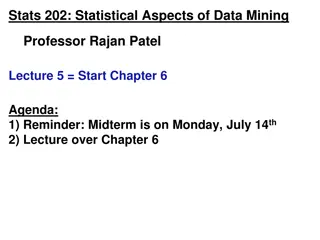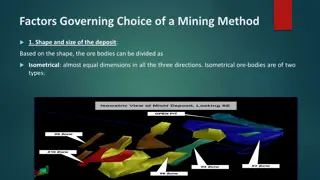Understanding Frequent Itemset Mining and the Apriori Algorithm
The process of frequent itemset mining and the Apriori algorithm are essential for analyzing customer behavior, patterns, and associations in retail data. This involves discovering relationships in large databases to improve marketing strategies, inventory management, and customer relationships. This article introduces the concepts, definitions, and significance of frequent itemset mining in data analysis.
Download Presentation

Please find below an Image/Link to download the presentation.
The content on the website is provided AS IS for your information and personal use only. It may not be sold, licensed, or shared on other websites without obtaining consent from the author. Download presentation by click this link. If you encounter any issues during the download, it is possible that the publisher has removed the file from their server.
E N D
Presentation Transcript
Frequent Itemset Mining and The Apriori algorithm Philippe Fournier-Viger http://www.philippe-Fournier-viger.com R. Agrawal and R. Srikant.Fast algorithms for mining association rules in large databases. Research Report RJ 9839, IBM Almaden Research Center, San Jose, California, June 1994. Source code and datasets available in the SPMF library 1
Introduction Many retail stores collect data about customers. e.g. customer transactions Need to analyze this data to understand customer behavior Why? for marketing purposes, inventory management, customer relationship management 2
Introduction Discovering patterns and associations Discovering interesting relationships hidden in large databases. e.g. beer and diapers are often sold together pattern mining is a fundamental data mining problem with many applications in various fields. Introduced by Agrawal (1993). Many extensions of this problem to discover patterns in graphs, sequences, and other kinds of data. 3
FREQUENT ITEMSET MINING 4
Definitions Let ? = ??,??, ?? be the set of items (products) sold in a retail store. For example: I= {pasta, lemon, bread, orange, cake} 5
Definitions A transaction database D is a set of transactions. D = {T1, T2, Tr} such that ?? ? (1 ? ?). Transaction Items appearing in the transaction T1 T2 T3 {pasta, lemon, bread, orange} {pasta, lemon} {pasta, orange, cake} T4 {pasta, lemon, orange, cake} 6
Definitions Each transaction has a unique identifier called its Transaction ID (TID). e.g.the transaction ID ofT4is 4. Transaction Items appearing in the transaction T1 T2 T3 {pasta, lemon, bread, orange} {pasta, lemon} {pasta, orange, cake} T4 {pasta, lemon, orange, cake} 7
Definitions A transaction is a set of items (an itemset). e.g. T2= {pasta, lemon} An item (a symbol) may not appear or appear once in each transaction. Each transaction is unordered. Transaction Items appearing in the transaction T1 T2 T3 {pasta, lemon, bread, orange} {pasta, lemon} {pasta, orange, cake} T4 {pasta, lemon, orange, cake} 8
Definitions A transaction database can be viewed as a binary matrix: Transaction pasta lemon bread orange cake T1 T2 T3 1 1 1 1 1 0 1 0 0 1 0 1 0 0 1 T4 1 1 0 1 1 Asymetrical binary attributes (because 1 is more important than 0) There is no information about purchase quantities and prices. 9
Definitions Let I bet the set of all items: I= {pasta, lemon, bread, orange, cake} There are 2|I| 1 = 25 1 = 31 subsets : {pasta}, {lemon}, {bread}, {orange}, {cake} {pasta, lemon}, {pasta, bread} {pasta, orange}, {pasta, cake}, {lemon, bread}, {lemon orange}, {lemon, cake}, {bread, orange}, {bread cake} {pasta, lemon, bread, orange, cake} 10
Definitions An itemset is said to be of size k, if it contains k items. Itemsets of size 1: {pasta}, {lemon}, {bread}, {orange}, {cake} Itemsets of size 2: {pasta, lemon}, {pasta, bread} {pasta, orange}, {pasta, cake}, {lemon, bread}, {lemon orange}, 11
Definitions The support (frequency) of an itemset X is the number of transactions that contains X. sup(X) = |{? | ? ? ? ?}| For example: The support of {pasta, orange} is 3. which is written as: sup({pasta, orange}) = 3 Transaction Items appearing in the transaction T1 T2 T3 {pasta, lemon, bread, orange} {pasta, lemon} {pasta, orange, cake} T4 {pasta, lemon, orange, cake} support = 12
Definitions The support of an itemset X can also be written as a ratio (absolute support). Example: The support of {pasta, orange} is 75% because it appears in 3 out of 4 transactions. Transaction Items appearing in the transaction T1 T2 T3 {pasta, lemon, bread, orange} {pasta, lemon} {pasta, orange, cake} T4 {pasta, lemon, orange, cake} 13
The problem of frequent itemset mining Let there be a numerical value minsup, set by the user. Frequent itemset mining (FIM) consists of enumerating all frequent itemsets, that is itemsets having a support greater or equal to minsup. Transaction Items appearing in the transaction T1 T2 T3 {pasta, lemon, bread, orange} {pasta, lemon} {pasta, orange, cake} T4 {pasta, lemon, orange, cake} 14
Example Transaction Items appearing in the transaction T1 T2 T3 {pasta, lemon, bread, orange} {pasta, lemon} {pasta, orange, cake} T4 {pasta, lemon, orange cake} For minsup= 2, the frequent itemsets are: {lemon}, {pasta}, {orange}, {cake}, {lemon, pasta}, {lemon, orange}, {pasta, orange}, {pasta, cake}, {orange, cake}, {lemon, pasta, orange} For the user, choosing a high minsup value, will reduce the number of frequent itemsets, will increase the speed and decrease the memory required for finding the frequent itemsets 15
Numerous applications Frequent itemset mining has numerous applications. medical applications, chemistry, biology, e-learning, etc. 16
Several algorithms Algorithms: Apriori, AprioriTID (1993) Eclat (1997) FPGrowth (2000) Hmine (2001) LCM, Moreover, numerous extensions of the FIM problem: uncertain data, fuzzy data, purchase quantities, profit, weight, time, rare itemsets, closed itemsets, etc. 17
ALGORITHMS 18
Nave approach If there are n items in a database, there are 2n -1 itemsets may be frequent. Na ve approach: count the support of all these itemsets. To do that, we would need to read each transaction in the database to count the support of each itemset. This would be inefficient: need to perform too many comparisons requires too much memory 19
Search space This is all the itemsets that can be formed with the items lemon (l), pasta (p), bread (b), orange (o) and cake (c) l p b o c lb lo lc pb lp po pc bo bc oc pbc poc boc lpb lpo lpc lbo lbc loc pbo l = lemon p = pasta b = bread 0 = orange c = cake lpbo lboc lpbc lpoc pboc lpboc This form a lattice, which can be viewed as a Hasse diagram 20
Search space If minsup = 2, the frequent itemsets are (in yellow): l p b o c lb lo lc pb lp po pc bo bc oc pbc poc boc lpb lpo lpc lbo lbc loc pbo l = lemon p = pasta b = bread 0 = orange c = cake lpbo lboc lpbc lpoc pboc lpboc 21
I={A} I={A, B} I={A, B,C} I={A, B,C,D} I={A, B,C,D,E} I={A, B,C,D,E,F} 22
How to find the frequent itemsets? Two challenges: How to count the support of itemsets in an efficient way (not spend too much time or memory)? How to reduce the search space (we do not want to consider all the possibilities)? 23
THE APRIORI ALGORITHM (AGRAWAL & SRIKANT, 1993/1994) R. Agrawal and R. Srikant. Fast algorithms for mining association rules in large databases. Research Report RJ 9839, IBM Almaden Research Center, San Jose, California, June 1994. 24
Introduction Apriori is a famous algorithm which is not the most efficient algorithm, but has inspired many other algorithms! has been applied in many fields, has been adapted for many other similar problems. Apriori is based on two important properties 25
Apriori property: Let there be two itemsets X and Y. If X Y, the support of Y is less than or equal to the support of X. Example: The support of {pasta} is 4 The support of {pasta, lemon} is 3 The support of {pasta, lemon, orange} is 2 Transaction Items appearing in the transaction T1 T2 T3 {pasta, lemon, bread, orange} {pasta, lemon} {pasta, orange, cake} T4 {pasta, lemon, orange, cake} (support is anti-monotonic) 26
Illustration minsup =2 l p b o c frequent itemsets lb lo lc pb lp po pc bo bc oc pbc poc boc lpb lpo lpc lbo lbc loc pbo Infrequent itemsets lpbo lboc lpbc lpoc pboc lpboc 27
This property is useful to reduce the search space. Example: If bread is infrequent minsup =2 l p b o c lb lo lc pb lp po pc bo bc oc pbc poc boc lpb lpo lpc lbo lbc loc pbo lpbo lboc lpbc lpoc pboc lpboc 28
This property is useful to reduce the search space. Example: If bread is infrequent, all its supersets are infrequent. minsup =2 l p b o c lb lo lc pb lp po pc bo bc oc pbc poc boc lpb lpo lpc lbo lbc loc pbo lpbo lboc lpbc lpoc pboc lpboc 29
Property 2: Let there be an itemset Y. If there exists an itemset X Y such that X is infrequent, then Y is infrequent. Example: Consider {bread, lemon}. If we know that {bread} is infrequent, then we can infer that {bread, lemon} is also infrequent. Transaction Items appearing in the transaction T1 T2 T3 {pasta, lemon, bread, orange} {pasta, lemon} {pasta, orange, cake} T4 {pasta, lemon, orange, cake} 30
The Apriori algorithm I will now explain how the Apriori algorithm works Input: minsup a transactional database Output: all the frequent itemsets Consider minsup =2. 31
The Apriori algorithm Step 1: scan the database to calculate the support of all itemsets of size 1. e.g. {pasta} support = 4 {lemon} support = 3 {bread} support = 1 {orange} support = 3 {cake} support = 2 32
The Apriori algorithm Step 2: eliminate infrequent itemsets. e.g. {pasta} {lemon} {bread} support = 1 {orange} support = 3 {cake} support = 2 support = 4 support = 3 33
The Apriori algorithm Step 2: eliminate infrequent itemsets. e.g. {pasta} {lemon} {orange} support = 3 {cake} support = 2 support = 4 support = 3 34
The Apriori algorithm Step 3: generate candidates of size 2 by combining pairs of frequent itemsets of size 1. Candidates of size 2 {pasta, lemon} {pasta, orange} {pasta, cake} {lemon, orange} {lemon, cake} {orange, cake} Frequent items {pasta} {lemon} {orange} {cake} 35
The Apriori algorithm Step 4: Eliminate candidates of size 2 that have an infrequent subset (Property 2) (none!) Candidates of size 2 {pasta, lemon} {pasta, orange} {pasta, cake} {lemon, orange} {lemon, cake} {orange, cake} Frequent items {pasta} {lemon} {orange} {cake} 36
The Apriori algorithm Step 5: scan the database to calculate the support of remaining candidate itemsets of size 2. Candidates of size 2 {pasta, lemon} support: 3 {pasta, orange} support: 3 {pasta, cake} support: 2 {lemon, orange} support: 2 {lemon, cake} support: 1 {orange, cake} support: 2 37
The Apriori algorithm Step 6: eliminate infrequent candidates of size 2 Candidates of size 2 {pasta, lemon} support: 3 {pasta, orange} support: 3 {pasta, cake} support: 2 {lemon, orange} support: 2 {lemon, cake} support: 1 {orange, cake} support: 2 38
The Apriori algorithm Step 6: eliminate infrequent candidates of size 2 Frequent itemsets of size 2 {pasta, lemon} support: 3 {pasta, orange} support: 3 {pasta, cake} support: 2 {lemon, orange} support: 2 {orange, cake} support: 2 39
The Apriori algorithm Step 7: generate candidates of size 3 by combining frequent pairs of itemsets of size 2. Candidates of size 3 {pasta, lemon, orange} {pasta, lemon, cake} {pasta, orange, cake} {lemon, orange, cake} Frequent itemsets of size 2 {pasta, lemon} {pasta, orange} {pasta, cake} {lemon, orange} {orange, cake} 40
The Apriori algorithm Step 8: eliminate candidates of size 3 having a subset of size 2 that is infrequent. Candidates of size 3 {pasta, lemon, orange} {pasta, lemon, cake} {pasta, orange, cake} {lemon, orange, cake} Frequent itemsets of size 2 {pasta, lemon} {pasta, orange} {pasta, cake} {lemon, orange} {orange, cake} Because {lemon, cake} is infrequent! 41
The Apriori algorithm Step 8: eliminate candidates of size 3 having a subset of size 2 that is infrequent. Candidates of size 3 {pasta, lemon, orange} {pasta, orange, cake} Frequent itemsets of size 2 {pasta, lemon} {pasta, orange} {pasta, cake} {lemon, orange} {orange, cake} Because {lemon, cake} is infrequent! 42
The Apriori algorithm Step 9: scan the database to calculate the support of the remaining candidates of size 3. Candidates of size 2 {pasta, lemon, orange} support: 2 {pasta, orange, cake} support: 2 43
The Apriori algorithm Step 10: eliminate infrequent candidates (none!) frequent itemsets of size 3 {pasta, lemon, orange} support: 2 {pasta, orange, cake} support: 2 44
The Apriori algorithm Step 11: generate candidates of size 4 by combining pairs of frequent itemsets of size 3. Candidates of size 4 Frequent itemsets of size 3 {pasta, lemon, orange} {pasta, lemon, orange, cake} {pasta, orange, cake} 45
The Apriori algorithm Step 12: eliminate candidates of size 4 having a subset of size 3 that is infrequent. Candidates of size 4 Frequent itemsets of size 3 {pasta, lemon, orange} {pasta, lemon, orange, cake} {pasta, orange, cake} 46
The Apriori algorithm Step 12: Since there is no more candidates, we cannot generate candidates of size 5 and the algorithm stops. Candidates of size 4 {pasta, lemon, orange, cake} Result 47
Final result {pasta} {lemon} {orange} {cake} support = 4 support = 3 support = 3 support = 2 {pasta, lemon} {pasta, orange} {pasta, cake} {lemon, orange} {orange, cake} support: 3 support: 3 support: 2 support: 2 support: 2 {pasta, lemon, orange} {pasta, orange, cake} support: 2 support: 2 48
Technical details Combining different itemsets can generate the same candidate. Example: {A, B} and { A,E} {A, B, E} {B, E} and { A,E} {A, B, E} problem: some candidates are generated several times! 49
Technical details Combining different itemsets can generate the same candidate. Example: {A, B} and { A,E} {A, B, E} {B, E} and { A,E} {A, B, E} Solution: Sort items in each itemsets (e.g. by alphabetical order) Combine two itemsets only if all items are the same except the last one. 50























